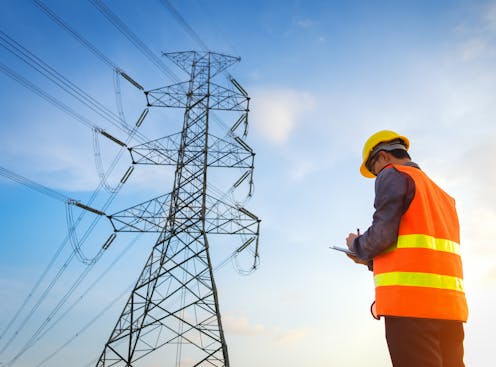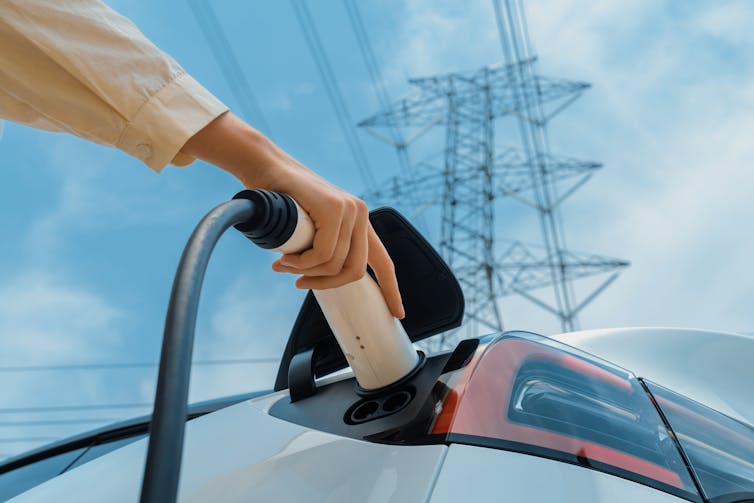Source: The Conversation (Au and NZ) – By Magnus Söderberg, Professor & Director, Centre for Applied Energy Economics and Policy Research, Griffith University

Building transmission lines is often controversial. Farmers who agree to host new lines on their property may be paid, while other community members protest against the visual intrusion. Pushback against new lines has slowed development and forced the government to promise more consultation.
It’s not a new problem. Communities questioned the routes of earlier transmission lines built during the 1950s-70s to link new coal and hydroelectric plants to the cities.
But this time, the transition has to be done at speed. Shifting from the old coal grid to a green grid requires new transmission lines. In its future system planning, Australia’s energy market operator sees the need for 10,000 kilometres of new transmission lines in the five states (and the Australian Capital Territory) which make up the National Energy Market.
Do we need all of these new transmission lines? Or will the “staggering growth” of solar on houses and warehouses coupled with cheaper energy storage mean some new transmission lines are redundant?
The answer depends on how we think of electricity. Is it an essential service that must be reliable more than 99.9% of the time? If so, yes, we need these new lines. But if we think of it as a regular service, we would accept a less reliable (99%) service in exchange for avoiding some new transmission lines. This would be a fundamental change in how we think of power.
Why do we need these new transmission lines?
The old grid was built around connecting a batch of fossil fuel plants via transmission lines to consumers in the towns and cities. To build this grid – one of the world’s largest by distance covered – required 40,000 km of transmission lines.
The new grid is based around gathering energy from distributed renewables from many parts of the country. The market operator foresees a nine-fold increase in the total capacity of large scale solar and wind plants, which need transmission lines.
That’s why the market operator lays out integrated systems plans every two years. The goal is to give energy users the best value by designing the lowest-cost way to secure reliable energy able to meet any emissions goals set by policymakers.
To avoid having to build transmission lines everywhere, policymakers have opted to group renewables in “renewable energy zones” with good wind or solar resources, and build transmission lines just to the zones.
According to the market operator, the major reasons why we need such a strong transmission network are:
– to harness flows of variable renewable power from different regions to make sure the system is reliable
– to cope with outages or shortfalls in supply. If a cloud band cuts solar farm output in one state, the grid can draw on solar from another state.
– boosting regional economies with advanced manufacturing and production of emerging green products and technologies.
So while 10,000 km sounds like a lot, it’s been kept to the minimum.

Ruud Morijn Photographer/Shutterstock
What if rooftop solar takes over?
Even so, some energy insiders question whether we need all these new transmission lines.
What if the growth of behind-the-meter energy resources such as rooftop solar, grid-connected home batteries and electric cars begin to cut demand from the grid?
About one in three households now have solar on their rooftops – the highest solar take up per capita in the world. And as more electric cars arrive in driveways, we will start using their large batteries as a backup power supply for our homes – or to sell the power on the grid. Could it be that cities could make their own power, as Nationals leader David Littleproud has called for?
Planners at Australia’s market operator do anticipate ever-greater levels of rooftop solar, batteries and electric vehicles. Their latest forecasts see these resources with enough capacity to power 30% of the grid by the end of the decade and 45% by mid-century.
These are substantial contributions, but not enough to power a nation. As we move to electrify everything, we will need to roughly double how much electricity we produce. Electricity is a much more efficient way to power transport, for instance, but switching from petrol to electric vehicles will mean more grid demand.
Having said that, we cannot be certain. When we model ways of giving up fossil fuels and ending emissions, there is always major uncertainty over what shape the future will take. Some technologies may splutter while others surge ahead.

Owlie Productions/Shutterstock
We could trade new transmission lines for a less reliable supply
At present, electricity is considered an essential service under national electricity laws. That means there has to be enough power 99.998% of the time. To meet that threshold, outages have to be kept to ten minutes in a year.
Making electricity an essential service is a choice. We could choose differently. If we decided electricity should be a regular service, where 99% reliability is OK (translating to outages of up to 87 hours a year), we would be able to get away with fewer new transmission lines.
That’s because wealthier households would likely respond to more outages by investing more in big solar arrays and batteries. Some would become energy self-sufficient and cut ties with the grid.
In this scenario, self-generation by the rich would mean a reduced demand on the grid, and we might be able to get away with building fewer new transmission lines.
But we should be careful here. If we took this approach, we would reshape society. The rich would be insulated while poorer households deal with the pain of power outages. The idea of the grid as a public good would begin to disappear.
![]()
The authors do not work for, consult, own shares in or receive funding from any company or organisation that would benefit from this article, and have disclosed no relevant affiliations beyond their academic appointment.
– ref. Is there an alternative to 10,000 kilometres of new transmission lines? Yes – but you may not like it – https://theconversation.com/is-there-an-alternative-to-10-000-kilometres-of-new-transmission-lines-yes-but-you-may-not-like-it-223964








